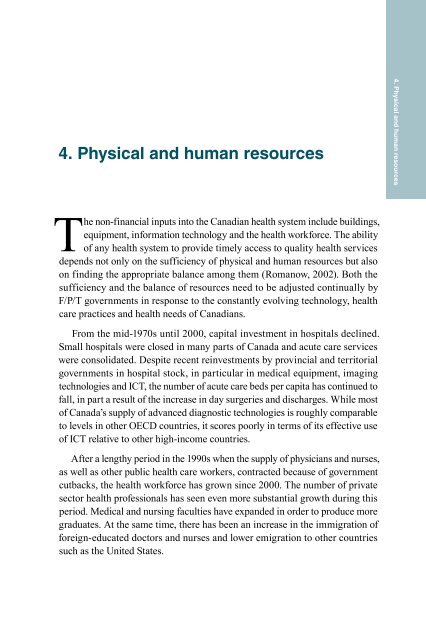Canada - World Health Organization Regional Office for Europe
Canada - World Health Organization Regional Office for Europe
Canada - World Health Organization Regional Office for Europe
You also want an ePaper? Increase the reach of your titles
YUMPU automatically turns print PDFs into web optimized ePapers that Google loves.
4. Physical and human resources<br />
The non-financial inputs into the Canadian health system include buildings,<br />
equipment, in<strong>for</strong>mation technology and the health work<strong>for</strong>ce. The ability<br />
of any health system to provide timely access to quality health services<br />
depends not only on the sufficiency of physical and human resources but also<br />
on finding the appropriate balance among them (Romanow, 2002). Both the<br />
sufficiency and the balance of resources need to be adjusted continually by<br />
F/P/T governments in response to the constantly evolving technology, health<br />
care practices and health needs of Canadians.<br />
From the mid-1970s until 2000, capital investment in hospitals declined.<br />
Small hospitals were closed in many parts of <strong>Canada</strong> and acute care services<br />
were consolidated. Despite recent reinvestments by provincial and territorial<br />
governments in hospital stock, in particular in medical equipment, imaging<br />
technologies and ICT, the number of acute care beds per capita has continued to<br />
fall, in part a result of the increase in day surgeries and discharges. While most<br />
of <strong>Canada</strong>’s supply of advanced diagnostic technologies is roughly comparable<br />
to levels in other OECD countries, it scores poorly in terms of its effective use<br />
of ICT relative to other high-income countries.<br />
After a lengthy period in the 1990s when the supply of physicians and nurses,<br />
as well as other public health care workers, contracted because of government<br />
cutbacks, the health work<strong>for</strong>ce has grown since 2000. The number of private<br />
sector health professionals has seen even more substantial growth during this<br />
period. Medical and nursing faculties have expanded in order to produce more<br />
graduates. At the same time, there has been an increase in the immigration of<br />
<strong>for</strong>eign-educated doctors and nurses and lower emigration to other countries<br />
such as the United States.<br />
4. Physical and human resources
















